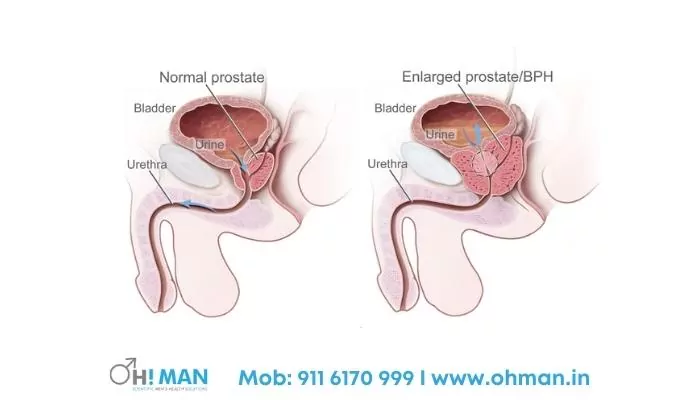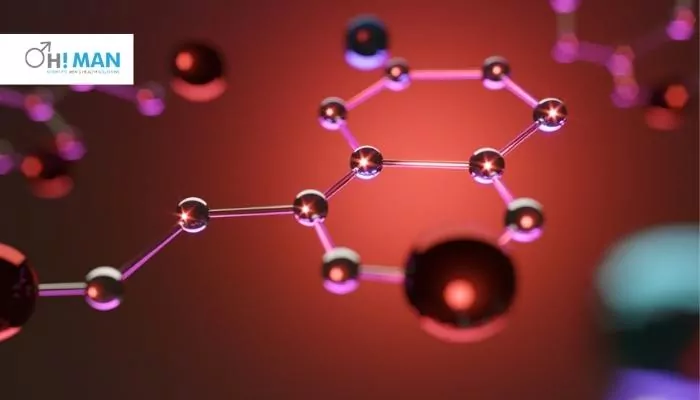Benign Prostatic Hyperplasia(BPH): Causes, Symptoms & Treatment
Benign Prostatic Hyperplasia(BPH): Causes, Symptoms & Treatment

Benign prostatic hyperplasia, known as BPH, is a noncancerous prostate gland enlargement in males. Benign prostatic hyperplasia is also called by the name of benign prostatic obstruction and benign prostatic hypertrophy.
The prostate has two distinct growth phases as a man matures. The first happens when the prostate grows in double size during early puberty. The second stage of a man’s development starts at age 25 and lasts most of his life. In many cases, BPH arises during the second growth phase.
As the prostate swells, the gland pushes on the urethra and restricts it. The wall of the bladder grows thicker. Gradually, the bladder may become weak and lose its capacity to empty, resulting in urine retention. The constriction of the urethra and urine retention — the failure to fully empty the bladder — are major contributors to the complications of benign prostatic hyperplasia.
What Is Prostate?
The walnut-shaped gland called the prostate is a member of the male reproductive system, and making fluid for semen is the primary function of the prostate. Further, a man’s ability to reproduce depends on his prostate fluid.
At the bladder’s neck, the gland encircles the urethra, and the urethra connects to the bladder at the bladder neck. The bottom of the urinary tract consists of the bladder and urethra. The prostate is positioned in the rectum front, right underneath the bladder, and consists of two or more lobes, or parts, surrounded by an external tissue layer. The tube that transfers urine from the bladder to out of the body is the urethra. Further, the urethra also transports semen from men via the penis.
Table of Contents
- Benign Prostatic Hyperplasia Causes
- How Common Is Benign Prostatic Hyperplasia In Men?
- Benign Prostatic Hyperplasia Symptoms
- Complications Caused Due To BPH
- Myth Surrounding BPH & Dhat Syndrome
- Benign Prostatic Hyperplasia Diagnosis
- Benign Prostatic Hyperplasia Treatment
- Aftermath-Of-BPH-Treatment
- Is benign prostatic hyperplasia serious?
- Bottom Line
Benign Prostatic Hyperplasia Causes
Benign prostatic hyperplasia mostly affects older men, although its exact aetiology is unclear. Further, men having testicles removed before adolescence do not experience benign prostatic hyperplasia. For this rationale, some experts think age and testicular factors may contribute to BPH causes.
Men produce little quantities of oestrogen, a female hormone, and testosterone, a masculine hormone, throughout their lifespan. Men’s active testosterone levels in blood decline with age, leaving a larger percentage of estrogen. According to scientific research, BPH may happen because the prostate’s greater estrogen content stimulates the function of molecules that encourage prostate cell growth.
Dihydrotestosterone (DHT), a male hormone that affects the growth and development of the prostate, is the subject of another hypothesis. Some studies have shown that elderly men continue to develop and deposit significant quantities of DHT in the prostate despite declining blood testosterone levels. So the buildup of DHT may promote the survival and growth of prostate cells. According to researchers, men who do not make DHT do not experience benign prostatic hyperplasia.
How Common Is Benign Prostatic Hyperplasia In Men?
The most frequent prostate problem in males over 50 is BPH. Although BPH seldom manifests symptoms before 40, incidence and symptoms rise with age. Around 50% of men between 51 and 60 years old and even 90% of men over 80 years have benign prostatic hyperplasia.
Benign Prostatic Hyperplasia Symptoms

BPH may cause various symptoms, all of which progressively worsen with time. Common BPH signs and symptoms include:
- Urge to urinate often or immediately
- Increased incidence of nocturnal urination
- Difficulty beginning to urinate
- Dribbling at the ending of urination or a weak or intermittent urine stream
- Pain following ejaculation or urination
- Unusual coloured or smelled urine
- Failure to empty the bladder completely
Less typical symptoms and indications include:
- urinary tract infection
- being unable to urinate
- Urine with blood in it
The prostate size does not always influence the extent of your symptoms. While some men with significantly enlarged prostates may only have moderate urinary symptoms, others with just mildly enlarged prostates may experience significant symptoms.
Some men’s symptoms gradually fade and may even improve with time.
Complications Caused Due To BPH
An enlarged prostate may cause complications such as:
- Unexpected difficulty in urinating (urinary retention): To eliminate the urine, your bladder may require placing a tube (catheter). Surgery may be necessary for certain men with enlarged prostates to treat urine retention.
- Bladder Stones: Kidney stones may occur due to the inability to empty your bladder. Infection, inflammation of the bladder, blood in urine, and restriction of urine flow are all possible effects of bladder stones.
- Urinary tract infections (UTIs): Your chance of developing a urinary tract infection may rise if you cannot empty your bladder. Further, you may need surgeries to remove a portion of the prostate if UTIs happen regularly.
- Bladder Damage: A bladder that doesn’t empty tends to expand and deteriorate with time. So it becomes more difficult to empty your bladder since its muscular wall doesn’t contract properly, making it challenging to empty the bladder.
These problems seldom occur in males with enlarged prostates. However, kidney injury and severe urine retention might pose major health risks. It is not thought that having an enlarged prostate increases your likelihood of getting prostate cancer.

Myth Surrounding BPH & Dhat Syndrome
Enlarged prostate & Benign prostatic hyperplasia causes semen to leak with the urine. In many part of India that it is misunderstood as Dhat syndrome without even knowing the cause of semen leakage. But Modern medicines like tadalafil are used to control the enlarged prostatic conditions and platform like Ohman already have solution for these myth and offer dhat ki dawa that helps control prostate enlargement along other medical causes & psychological causes to control the Dhat syndrome. Now let’s check out how BPH is diagnosed & what kind of treatment procedure is taken to control it.
Benign Prostatic Hyperplasia Diagnosis
Family and Personal Medical Background
Among the first steps a health care practitioner may take to identify benign prostatic hyperplasia properly is to get a patient’s medical history. A doctor may inquire about a man’s health, including:
- the present symptoms
- when the symptoms start and occur, how often
- in case of any record of recurrent UTIs
- medications, including prescription and OTC
- liquid consumption daily
- any caffeine or alcohol consumption
- overall medical history, along with any major illnesses or operations
Physical Examination
A physical examination may aid in the diagnosis of benign prostatic hyperplasia. During a physical examination, a health care practitioner will most likely:
- checks a patient’s body, which may involve looking for urethral discharge, enlarged or sore lymph nodes in the groin, a swollen or sensitive scrotum
- Tapping on particular locations of the patient’s body.
- performing a digital rectal exam
A digital rectal examination, often called as a rectal exam, is a physical examination of the prostate gland. So a rectal exam is often performed in an office visit by a health care professional, and males do not need anesthesia. Further, the examination allows the doctor to check whether the prostate is swollen or sensitive or if any anomalies need further testing.
Medical Tests
A urologist utilizes medical tests to identify and address lower urinary tract issues caused by benign prostatic hyperplasia. Medical examinations may involve:
- urinalysis to check signs of urine infection
- urodynamic tests to check how the bladder and urethra stores and releases urine
- a prostate-specific antigen (PSA) blood test to check if prostate cancer is developing
- cystoscopy to look inside the bladder and urethra and identify any stocks or blockages in the urinary tract
- biopsy to detect the presence of cancer
- transrectal ultrasound to show any abnormalities and tumours due to the prostate’s size
Benign Prostatic Hyperplasia Treatment
A doctor will treat benign prostatic hyperplasia based on the intensity of the symptoms, how the manifestations interfere with a man’s everyday life, and the man’s desires.
Men with a moderately enlarged prostate might not receive treatment unless these symptoms are unpleasant and compromise their quality of life. Further, a urologist may prescribe frequent checks instead of treatments in some circumstances. A urologist would usually prescribe therapy if the indications of benign prostatic hyperplasia develop uncomfortably or pose a health concern.
Various treatment approaches include:
Lifestyle Changes
A health care practitioner may suggest lifestyle adjustments for males with moderate or light troublesome symptoms. So changing lifestyle may include:
- limiting liquid intake, especially before leaving the house or before sleeping
- preventing or limiting consumption of caffeinated drinks and alcohol
- avoiding or limiting the intake of prescription drugs These include anti-histamines, decongestants, diuretics and anti-depressants.
- working out the pelvic floor muscles
- bladder training for retaining more urine for extended periods
- constipation prevention or treatment
Medications
The health care practitioner or urologist might prescribe medications to slow or halt prostate development or alleviate symptoms of benign prostatic hyperplasia. So the medications include:
- Alpha-blockers: These medicines calm the smooth muscles of the bladder neck, and prostate, allowing urine to flow more freely and reducing bladder obstruction.
- 5-alpha reductase inhibitors: These drugs inhibit the DHT production, which builds up in the prostate and may start causing prostate growth.
- Phosphodiesterase-5 inhibitors: Tadalafil (Cialis) is a drug in this family that helps relieve lower urinary tract discomfort by calming smooth muscles within the lower urinary tract. Researchers are investigating the relevance of erectile dysfunction medications in the long-term management of BPH.
- Combination medications: If either medicine alone is ineffective, your doctor may advise you to take a 5-alpha reductase inhibitor and an alpha-blocker simultaneously.
Minimally Invasive Procedures
When drugs fail to treat BPH symptoms, researchers may use a range of minimally invasive techniques. These processes include the following:
- transurethral electrovaporization
- transurethral microwave thermotherapy
- high-intensity focused ultrasound
- water-induced thermotherapy
- prostatic stent insertion
- transurethral needle ablation
Minimally invasive treatments may help reduce obstruction and urine retention associated with benign prostatic hyperplasia by destroying enlarged prostate tissues or widening the urethra.
Urologists use the transurethral approach to undertake minimally invasive operations. So this involves introducing a catheter (a narrow, flexible pipe) or cystoscope into the urethra to enter the prostate. Local, regional, or general anesthesia may be required for these operations.
Although removing bothersome prostate tissue alleviates many BPH symptoms, it does not resolve the condition. Depending on the man’s symptoms and general condition, a urologist will choose which surgery to undertake.
Aftermath Of BPH Treatment
Most men’s BPH symptoms resolve the following treatment. Some treatments may result in infections, bleeding, leakage, and erectile dysfunction. Scar tissue may occur in various instances.
Sexual function may not recover completely after surgery. Most specialists feel that if you had an erection preceding surgery, you would have one after that. Additionally, y our orgasm is unlikely to vary. In certain situations, males may suffer retrograde ejaculation, which occurs when sperm enters the bladder instead of exiting the penis.
Further, side effects vary depending on the kind of therapy chosen, and most negative effects are temporary. After initial therapy, some men require additional or new treatment for their BPH symptoms.
Is benign prostatic hyperplasia serious?
Benign prostatic hyperplasia (BPH) is not a life-threatening disorder, although it may result in urinary issues. BPH may affect males of any age, although it is more prevalent in those over 50. BPH is not cancer, nor does it raise the chance of developing prostate cancer.
Bottom Line
There is currently no technique to avoid benign prostatic hyperplasia. Men at risk should see their doctor about any urinary tract symptoms and the necessity for frequent prostate examinations. By detecting lower urinary tract signs and diagnosing an enlarged prostate, men may get appropriate treatment and limit the consequences of benign prostatic hyperplasia.
In case you have any sexual health concerns like erectile dysfunction, premature ejaculation, and any other concerns, then Ohman can offer you treatment. Book an online consultation and solves your sexual health concerns.



